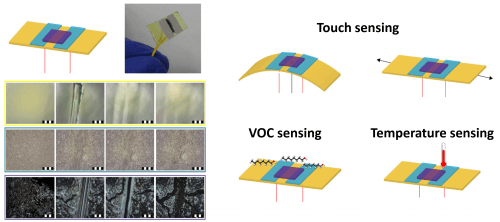A flexible sensing platform developed by Prof. Hosem Hayek of the Technion repairs itself in case of cuts and scratches

Technion researchers have developed a flexible functional sensing platform that repairs itself autonomously in the event of a cut or scratch. This is a platform that senses touch (pressure and stretch), heat and volatile particles. Possible applications: electronic skin, which simulates human skin in its way of working and continuously monitors the health status of the person through stickers attached to the body; touch screens that preserve their transparency and uniformity over time; Transistors are electrical circuits that constantly repair their defects (thus their performance is not damaged), and more. The research, conducted at the Faculty of Chemical Engineering and the Russell Berry Institute for Nanotechnology at the Technion, was recently published in the leading journal Advanced Materials.

The developers of the innovative platform, researcher (postdoctoral student) Dr. Tan-Pat Yoon and Prof. Hussam Haik, head of the laboratories for nanomaterials-based devices at the Technion, explain that "our development is based on new types of artificial polymers with controlled electrical and chemical properties. The unique chemical composition of the polymers gives them the ability to self-repair anywhere on the surface of the electrical device. In other words, cuts and scratches in all parts of the device 'heal' themselves autonomously and quickly, within 30-10 minutes from the moment of damage."
"On the basis of the polymer we developed, we built an entire device made of a flexible chemical agent that can be bent and stretched," explains Prof. Haik. "The ability to self-repair exists in all parts of the device, so wherever the platform is 'injured' it renews itself. Thus the complete device continues to function as an accurate sensor of temperature, contact and volatile particles." In detecting volatile particles, the device is characterized by extremely high sensitivity: it detects dozens of target particles that are in a mixture of a billion other particles.
The researchers were inspired by the human skin, which regenerates continuously and, moreover, is able to heal itself in case of injury. In the experiments conducted on the new device, it became clear that during six months of continuous operation, which includes random "injuries" of the platform, the device loses less than 10% of its sensitivity level.

2 תגובות
I have a feeling that the writer of the headline is not the writer of the article (and maybe didn't even understand it)...